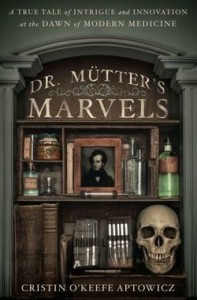19th-c. Surgical Books
I’m a book collector, and I’ve gone through phases in collecting. Most recently, my focus has been nineteenth- and early twentieth-century medical books, particularly those illustrated with “gruesome” surgical images. Which is why Cinemax’s new show, The Knick, and a new book, Dr. Mütter’s Marvels: A True Tale of Intrigue and Innovation at the Dawn of Modern Medicine, are totally up my alley.
 Gory medical scenes in director Steven Soderbergh’s brainchild, The Knick, make viewers squirm. The new series, which debuted on August 8, is certainly not for the squeamish. Five minutes into the first episode, we’re already watching a surgeon slice into an anesthetized pregnant woman in his twelfth unsuccessful—and deadly—attempt at a C-section. And yet, the show’s bloodiness pales in comparison to the torture described in a fascinating new book by Cristin O’Keefe Aptowitz, Dr. Mütter’s Marvels: A True Tale of Intrigue and Innovation at the Dawn of Modern Medicine (Gotham Books, Sept.). The difference? Ether.
Gory medical scenes in director Steven Soderbergh’s brainchild, The Knick, make viewers squirm. The new series, which debuted on August 8, is certainly not for the squeamish. Five minutes into the first episode, we’re already watching a surgeon slice into an anesthetized pregnant woman in his twelfth unsuccessful—and deadly—attempt at a C-section. And yet, the show’s bloodiness pales in comparison to the torture described in a fascinating new book by Cristin O’Keefe Aptowitz, Dr. Mütter’s Marvels: A True Tale of Intrigue and Innovation at the Dawn of Modern Medicine (Gotham Books, Sept.). The difference? Ether.
The Knick is set in a fictional version of the real Knickerbocker Hospital in New York City in 1900, a relatively modern age for medicine. By then, at least, doctors understood that cleanliness, particularly sterilized hands and tools, could seriously diminish the spread of infection. They also had the ability to chemically induce sleep in patients who needed surgical treatment. Not so the physicians in Dr. Thomas Dent Mütter’s time, only sixty years earlier. When he cut into a patient, she felt every incision. During one of the surgeries chronicled by Aptowitz, Mütter removes a chunk of skin from the neck of a 28-year-old woman, who, having been badly burned at the age of 5, was considered a “monster.” With one attendant to restrain her, Mütter took his scalpel to her neck “deep enough to get through the heavy scar tissue, but light enough to, hopefully, avoid the delicate muscles of the neck and the heavily trafficked arteries and veins.” And after he had finished with that, the second stage of the surgery commenced. “The woman tried to stifle her cry as Mütter carved out a piece of skin from her back—six and half inches in length, by six in width, slightly larger but the same shape as the wound on the front of her neck.” He had created a “flap,” which was then lifted over her shoulder and stitched onto her damaged neck—all of that, without so much as a drop of nitrous oxide (they prescribed mouthfuls of wine, as needed). He then starved her for almost a week, which was considered ‘best practices,’ and she lived.
The Virginia-born Mütter studied medicine at the University of Pennsylvania and in Paris, but returned to Philadelphia to lead an American renaissance in medical care. This was a world, Aptowitz reminds readers, where bleeding a patient, with a lancet or a leech, was a common treatment for just about anything, and “one in every four births resulted in the death of the infant.” Add to that a lack of electricity, regular outbreaks of cholera, typhus, and dysentery, plus the ubiquitous tuberculosis, and you can understand when the author writes, “Philadelphia in the early 1800s was an easy place to die.”
Dr. Mütter’s particular interest was plastic surgery and helping those with congenital or acquired deformities; he sewed up cleft palates and removed unsightly tumors. As the brash, young chair of surgery at the startup Jefferson Medical College, he inspired thousands of students, facilitated the building of a teaching hospital, championed sanitary practices even though germ theory was still being debated in American medical schools, and introduced the use of ether anesthesia in Philadelphia after two Boston doctors gave the first-ever public demonstration of the drug in October of 1846. (Philadelphia was not impressed; the board of the city’s Pennsylvania Hospital voted to ban surgical anesthesia for seven years.)
Mütter was an innovator, a bit more industrious and a bit less drug-addled, perhaps, than his counterpart on The Knick, Dr. John Thackery, played by Clive Owen, but Thackery has his moments, too. When faced with an emergency procedure for a man dying of septicemia who also has bronchitis and cannot be put under, the good doctor improvises with a cocaine epidural. A bold and historically appropriate move—the show’s writers and producers have done their homework—because attempting the surgery without sedation would have been impossible, right? Thackery informs his students, “We must operate but we cannot do it to a man who will feel pain.”
That’s why Mütter and his colleagues, even the obtuse ones who refused to believe in contagion, seem quite heroic in Aptowitz’s engaging book. They sawed off entire limbs to the sound of blood-curdling screams, knowing full well that many on whom they labored would die anyway.
Mütter, the handsome and well-dressed doctor with audacious ideas, was not exactly lost to history before Aptowitz picked up his trail, but interest in early medicine—and his Mütter Museum, which he founded with his own collection of anatomical specimens and oddities and $30,000 just before his early death at age 48—was certainly relegated to a small group of fans who like a little history with their blood and guts. Those of us who visit places like the The Morbid Anatomy Museum, watch shows like The Knick, and read books like this one.
